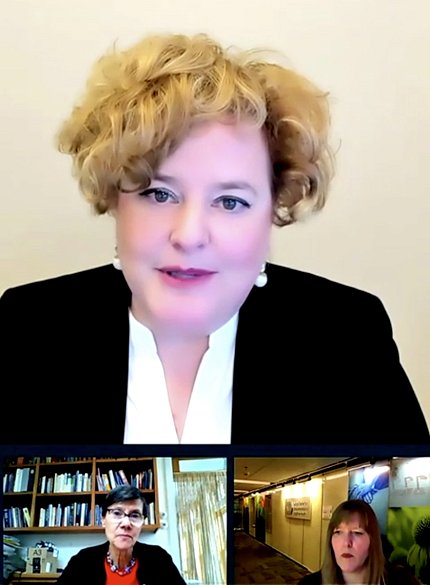Zenk Examines How Communities Affect Our Health

For many of us, getting through the Covid-19 pandemic has brought us face-to-face at times with questions such as the role of place in our lives: Where did we come from, how have those communities shaped us, and where do we want to be—now and in the future?
In a virtual lecture, “All Health Is Not Created Equal: Where You Live Matters,” NINR director Dr. Shannon Zenk discussed her research, which has revealed that the places people live shape their health more than they may know. Her talk was the National Center for Complementary and Integrative Health’s 2020 Stephen E. Straus Distinguished Lecture in the Science of Complementary Therapies, honoring the center’s founding director.
Focusing on the science behind social determinants of health—or “the conditions in which people are born, work, live, play and age”—Zenk illustrated how communities vary dramatically both in resources (e.g., jobs, attractive parks, healthier foods and places to exercise) and hazards.
“Some say that ‘zip code is more important for your health than your genetic code,’” she noted. “Differences between community environments are…thought to drive some of the large, persistent health disparities observed across our country and within our cities.” An example is when people living in neighborhoods just a few miles apart differ greatly in life expectancy.
A leading population health researcher and registered nurse, Zenk shared how her background in nursing shaped her research on community environments. Early in her career as a home-health nurse case manager, she visited patients in diverse neighborhoods running the gamut “from privileged to poverty” and found many needs beyond medical ones. Zenk cited a strength of nursing as “the holistic perspective we bring to health and health care,” which has long driven nurses in “supporting people to promote and restore their health…by addressing needs at multiple levels—physical, emotional, social and environmental.”
Some of her graduate school projects conducted in disadvantaged, urban communities in Detroit and Chicago provided another major influence. Themes she heard consistently included “rundown food stores, a scarcity of healthy foods, the ubiquity of unhealthy options and a lack of safe places to engage in physical activity.”
So Zenk began to study more closely how resources were distributed across communities and the resulting implications for people’s health. One of her innovations has been to study people’s usual activity spaces by using geographic information systems (such as GPS), spatial analysis and wearable devices.
Zenk’s research was further shaped by the public health crisis of rising obesity levels and their associated health risks. She and her colleagues conducted one of the first U.S. studies on “food deserts”—areas that have poor access to grocery stores, supermarkets and farmers markets.
“Tens of millions of Americans live in these deserts, and millions in pharmacy deserts,” she said.
In one study, her team found that low-income Black communities had less access to supermarkets that tend to offer the widest selection of healthy foods—such as prepared salads—and had more access to unhealthy food options, compared with higher income and/or White communities. Often, healthier foods were also more expensive in Black communities. Another topic of interest for Zenk has been body mass index (BMI) in relation to such aspects of local environments as walkability or proximity to fast food restaurants and mass-merchandise stores. Zenk has found some intriguing relationships in cross-sectional studies that call for confirmation in research with more rigorous designs.
Zenk’s work in food deserts has been critical in building an evidence base for policy solutions to improve access to healthy foods in underserved communities. She noted that improving community environments, such as by opening a grocery store, to advance health and reduce health disparities is critical but may not be a sufficient solution. The problem is complex and often calls for multicomponent, multilevel solutions—a strategy that complements NCCIH’s focus on integrative health.
“It might not be enough to work with folks to eat better or engage in physical activity,” Zenk said. “We may in tandem need to improve their environments. This is a challenging area because [many] experimental designs are so difficult or would be unethical…We need to build the evidence on what policies and environmental changes may be most promising. The field could make better use of natural experiments.”
Zenk noted the impact of many of these same issues on Covid-19. “At a time when getting outside for a walk or to exercise or even just for fresh air is helpful to relieve stress, promote health and manage other health conditions,” she said, “adequate park and green space is essential.”
Research has linked greater community greenness to lower Covid-19 incidence, Zenk pointed out.
“COVID-19 will likely have long-lasting consequences for the public’s health and health inequities, in part because of its powerful effects on social factors, including community environments,” she said.
“Not all health is created equal,” Zenk concluded, “but there are things that we can do and must do. There are dramatic inequities in the conditions in which people are born, work, play and age, and in their opportunities and resources to be healthy. These inequities show up in people’s health. We need research, including to discover not just what micro-interventions, but critically, what upstream macro-level policy and approaches can advance good health for all.”
The full lecture is archived at https://videocast.nih.gov/watch=40083.
